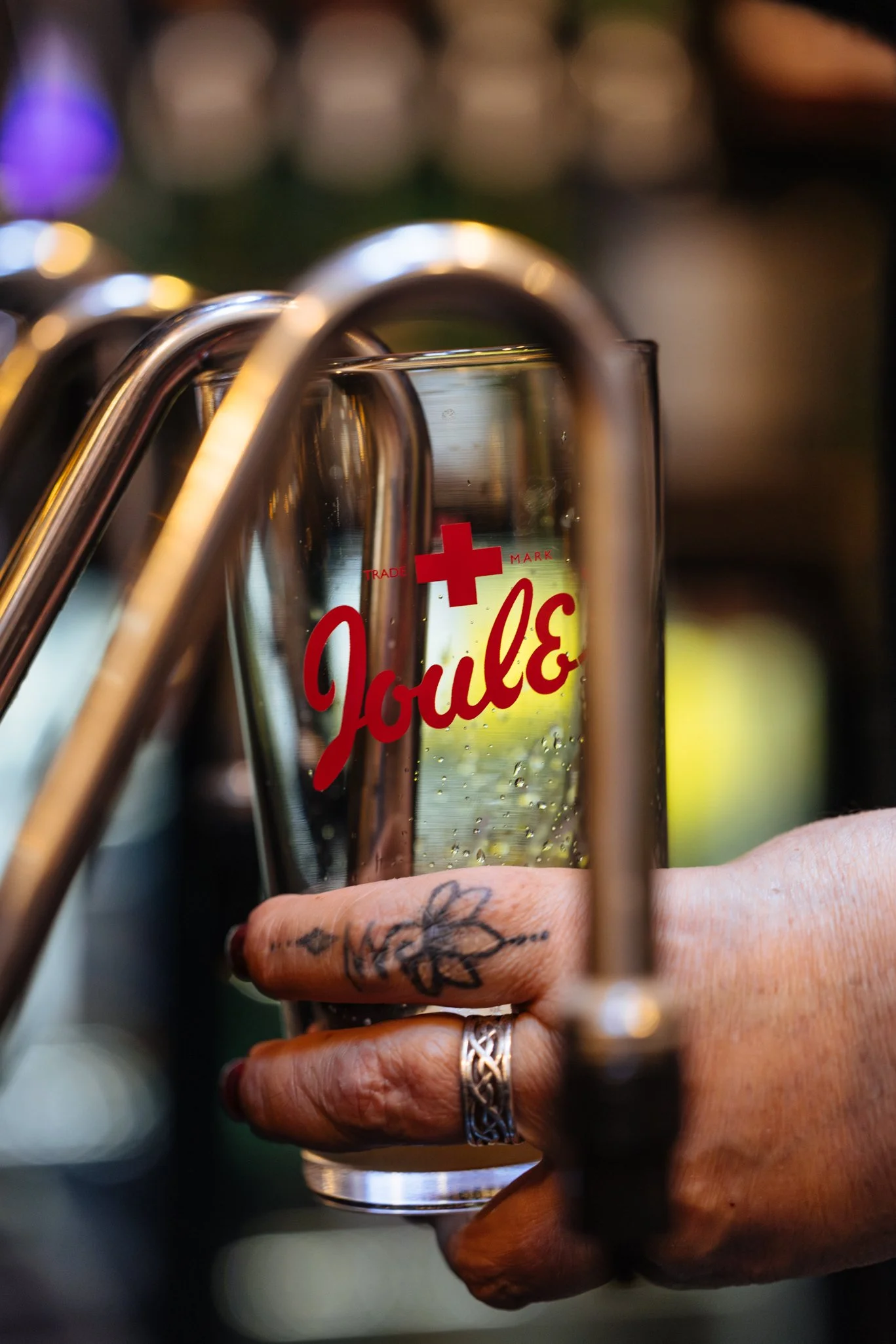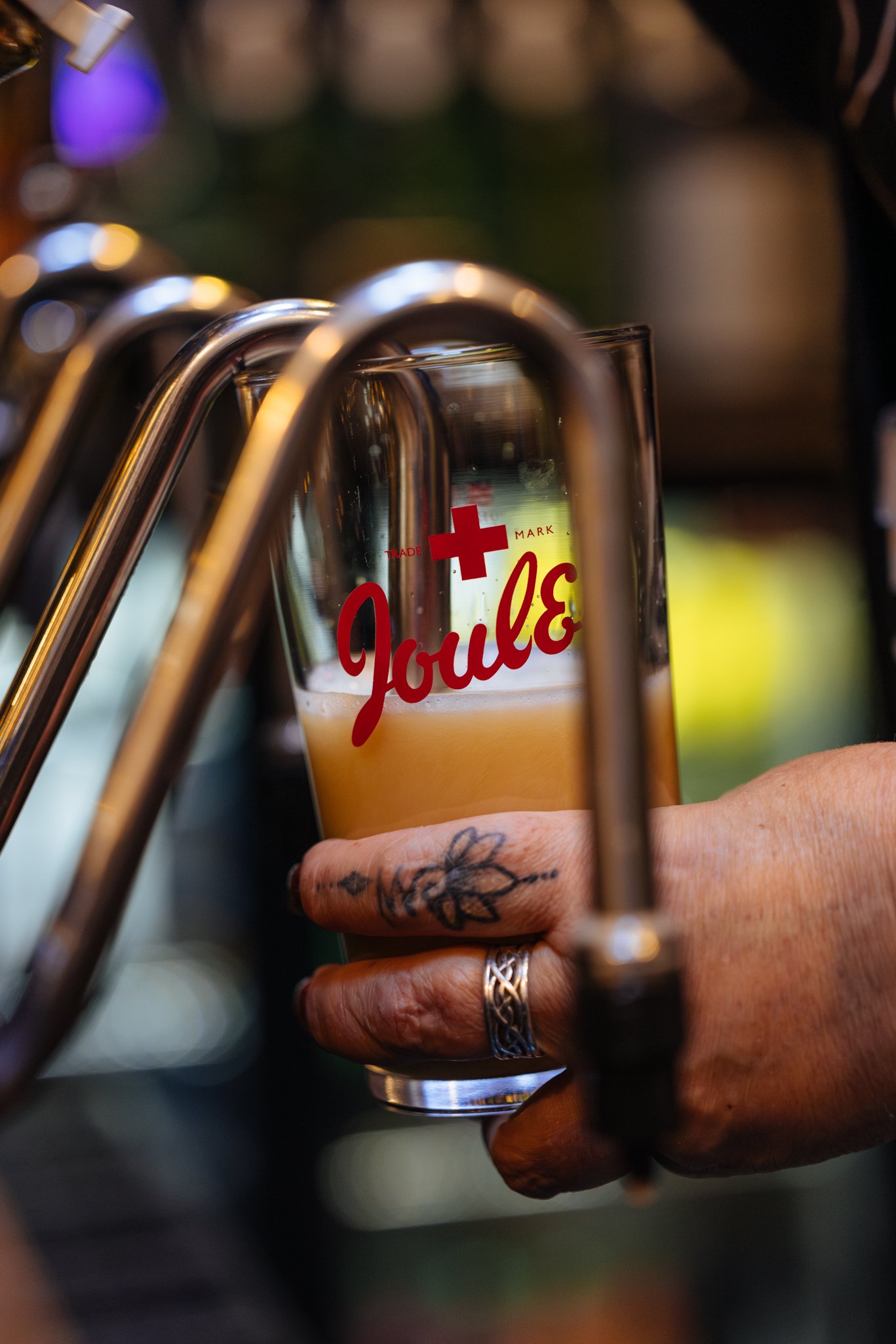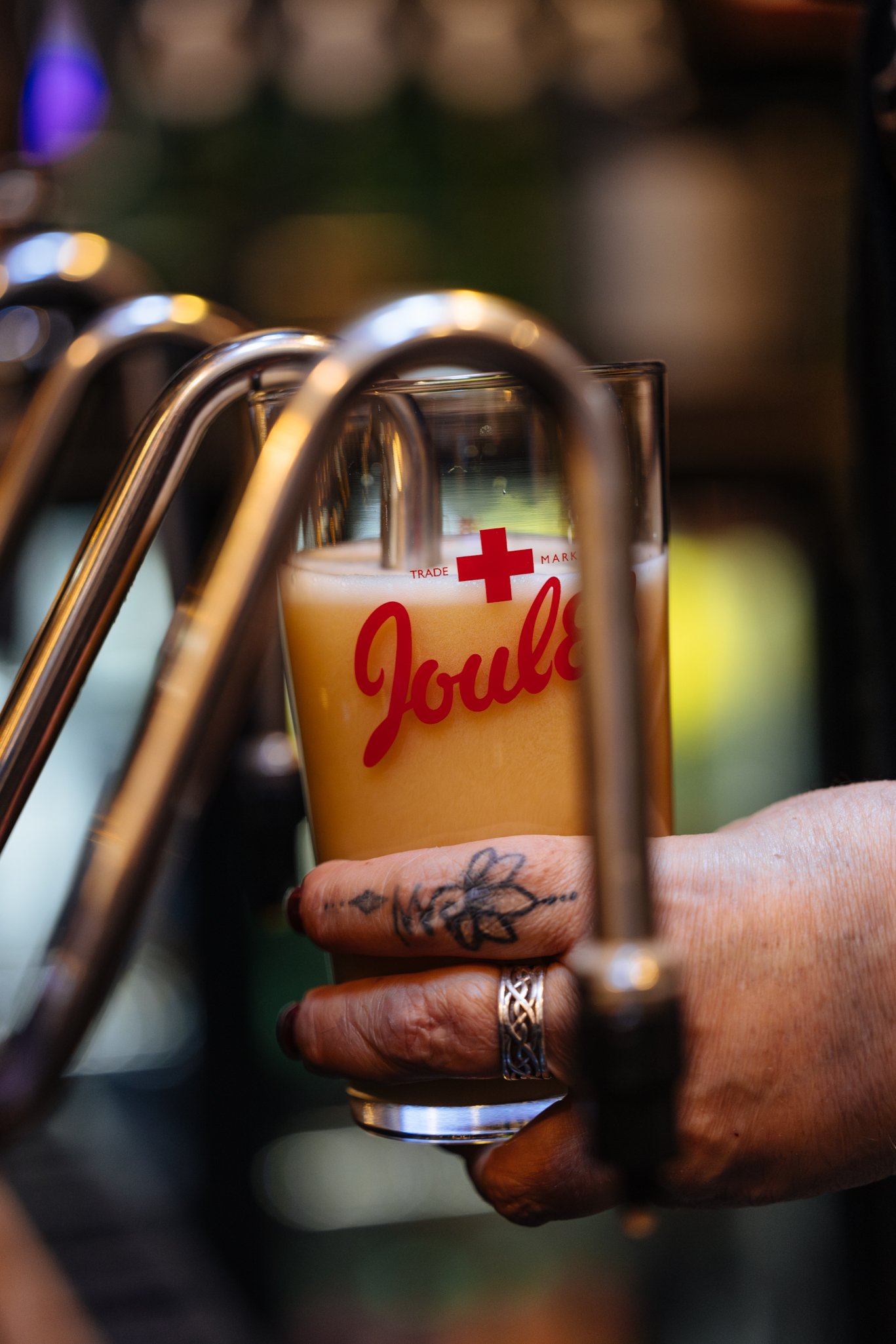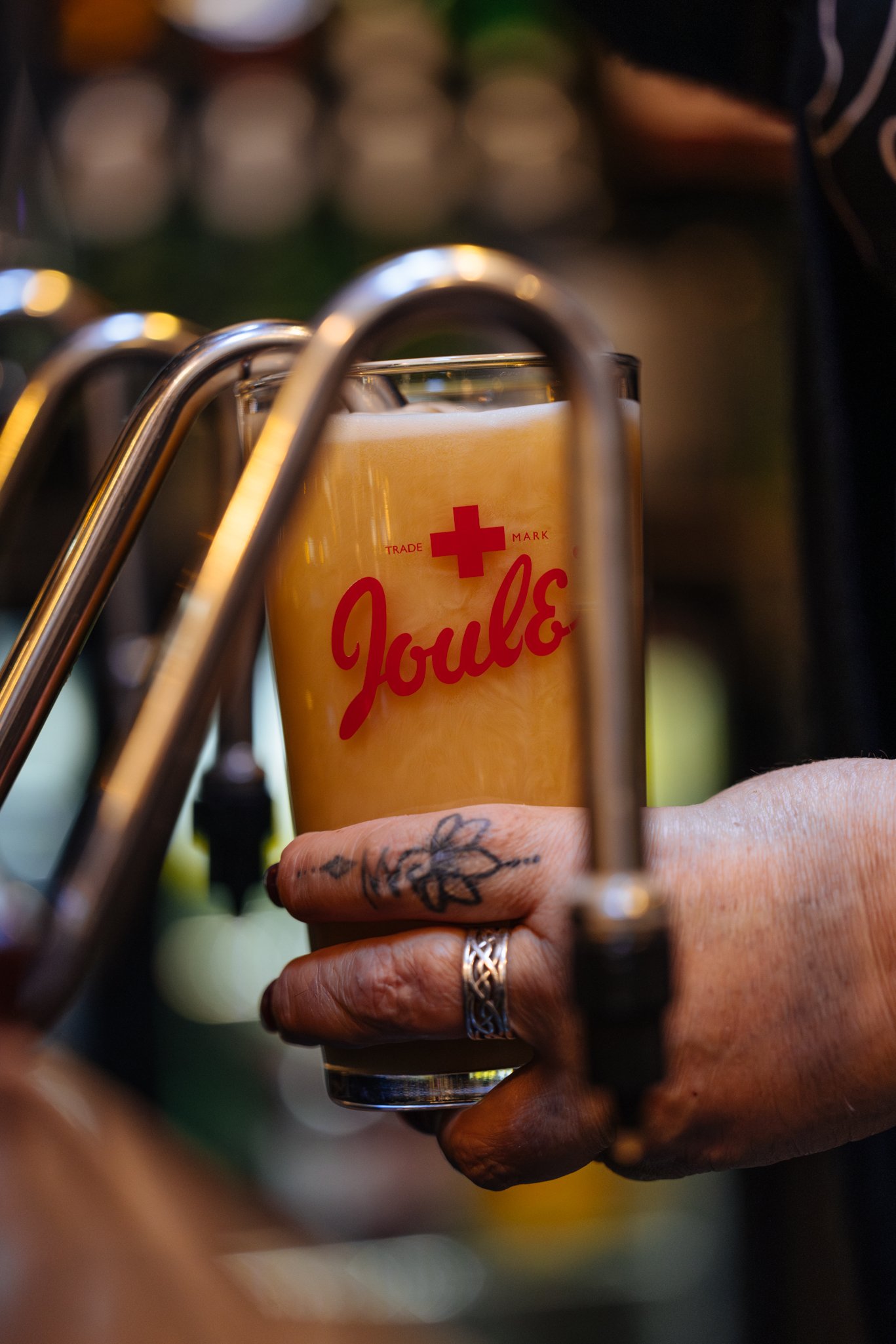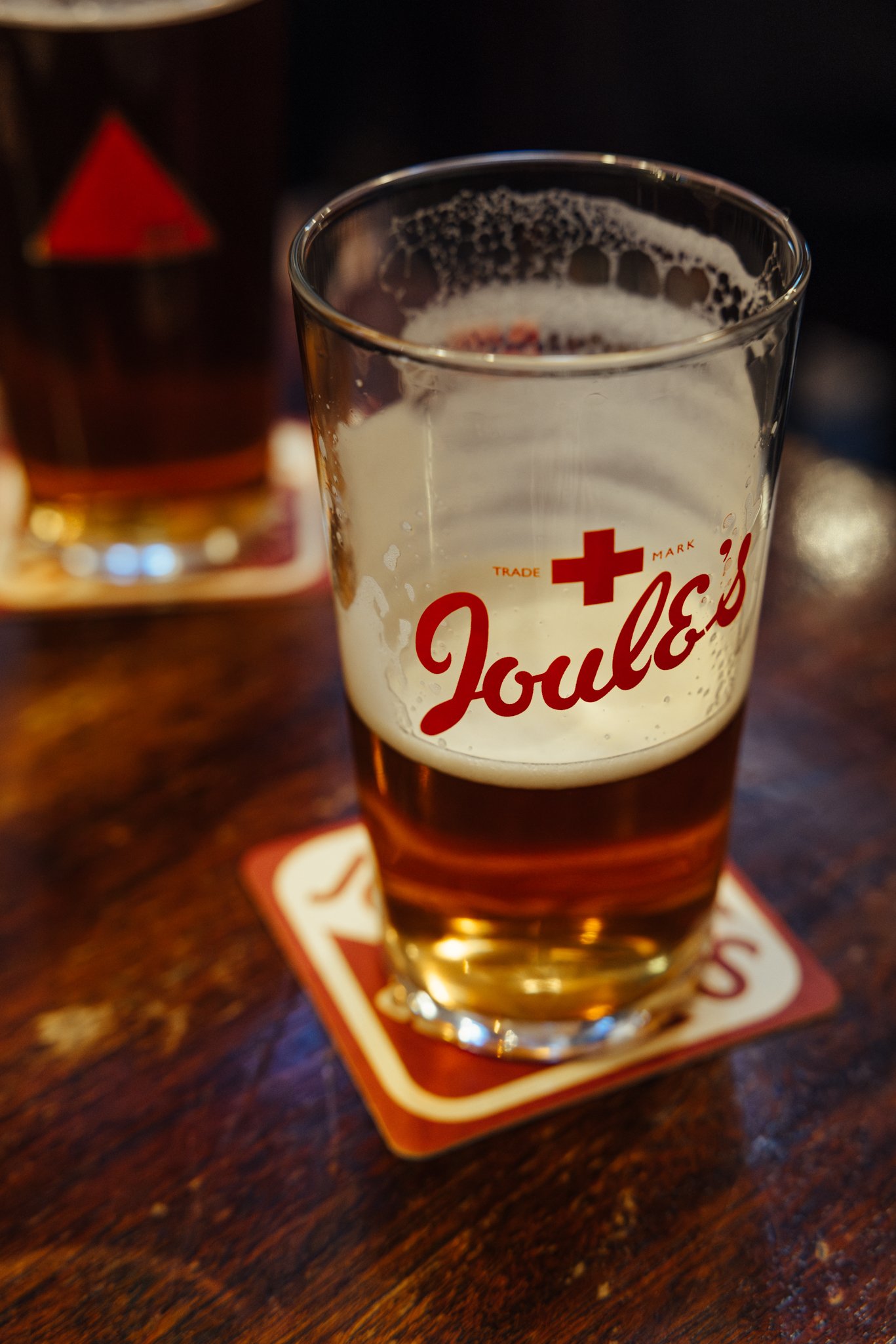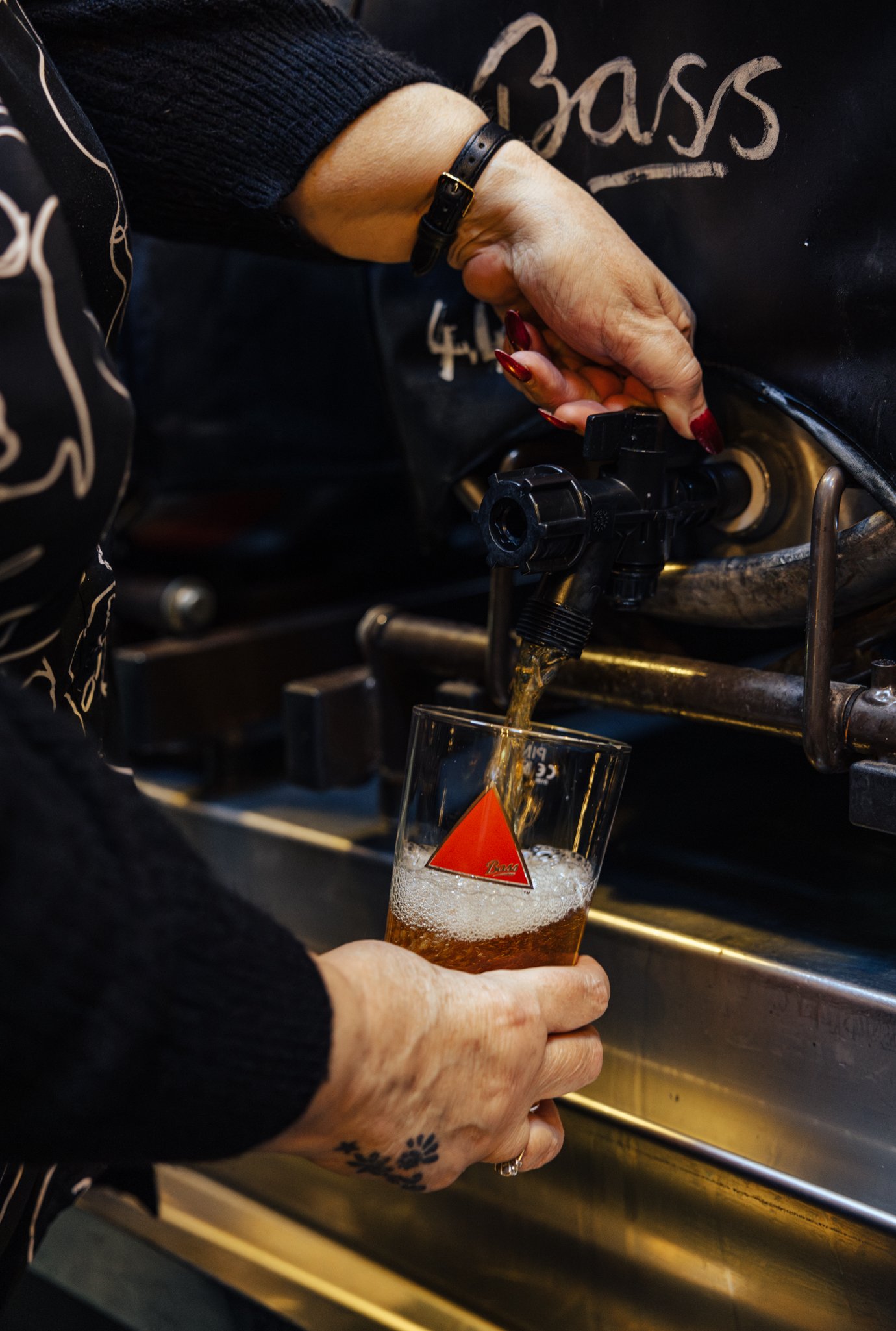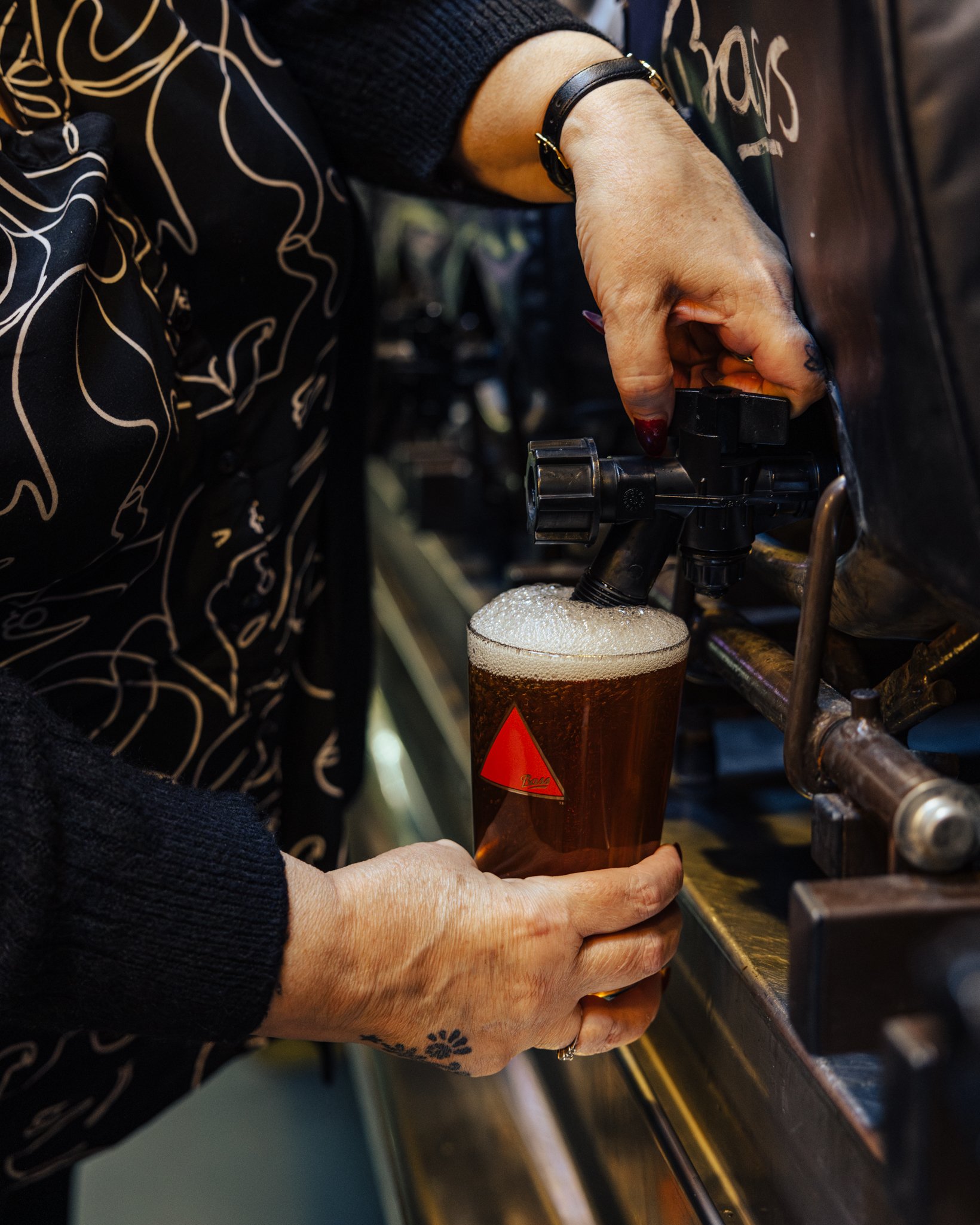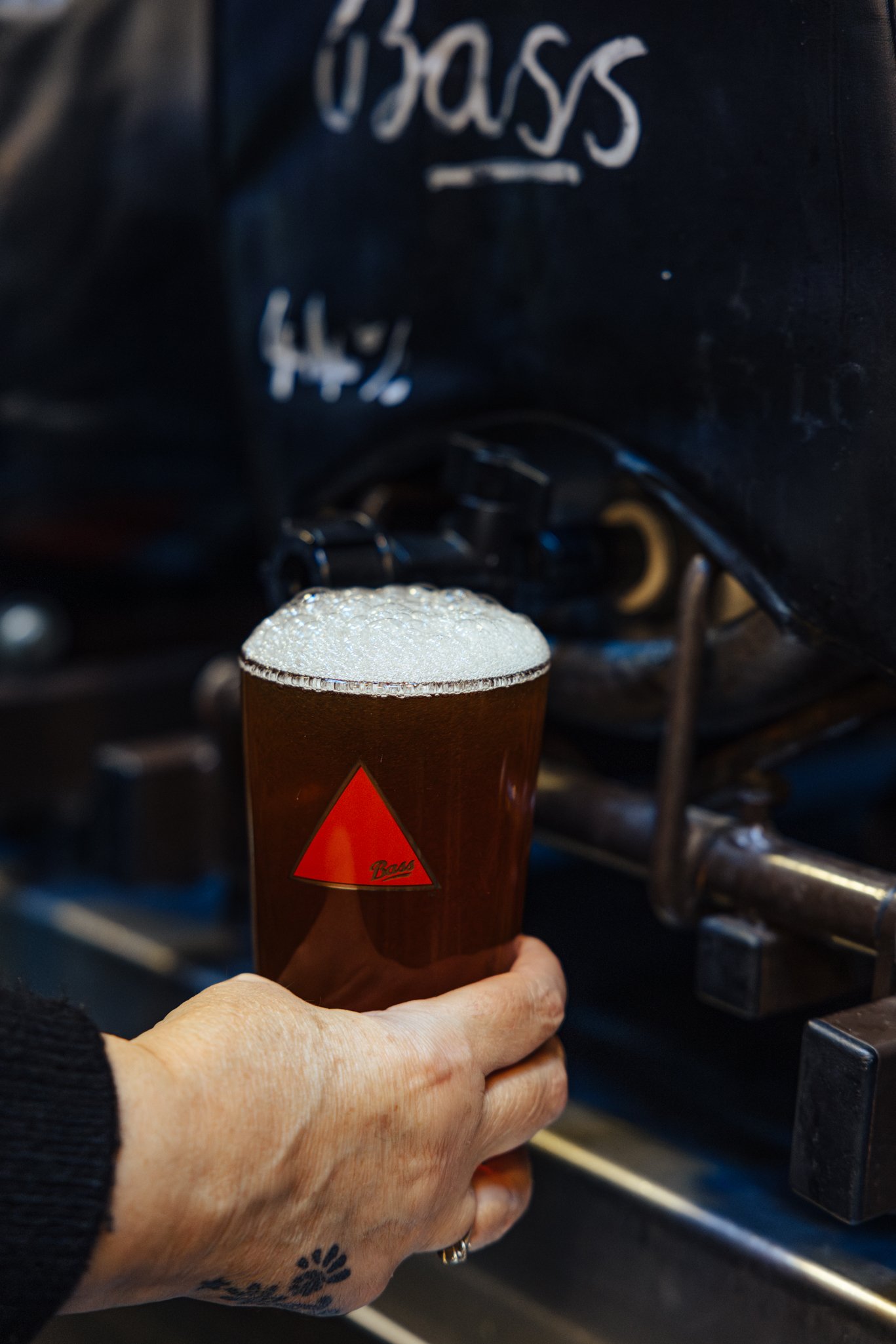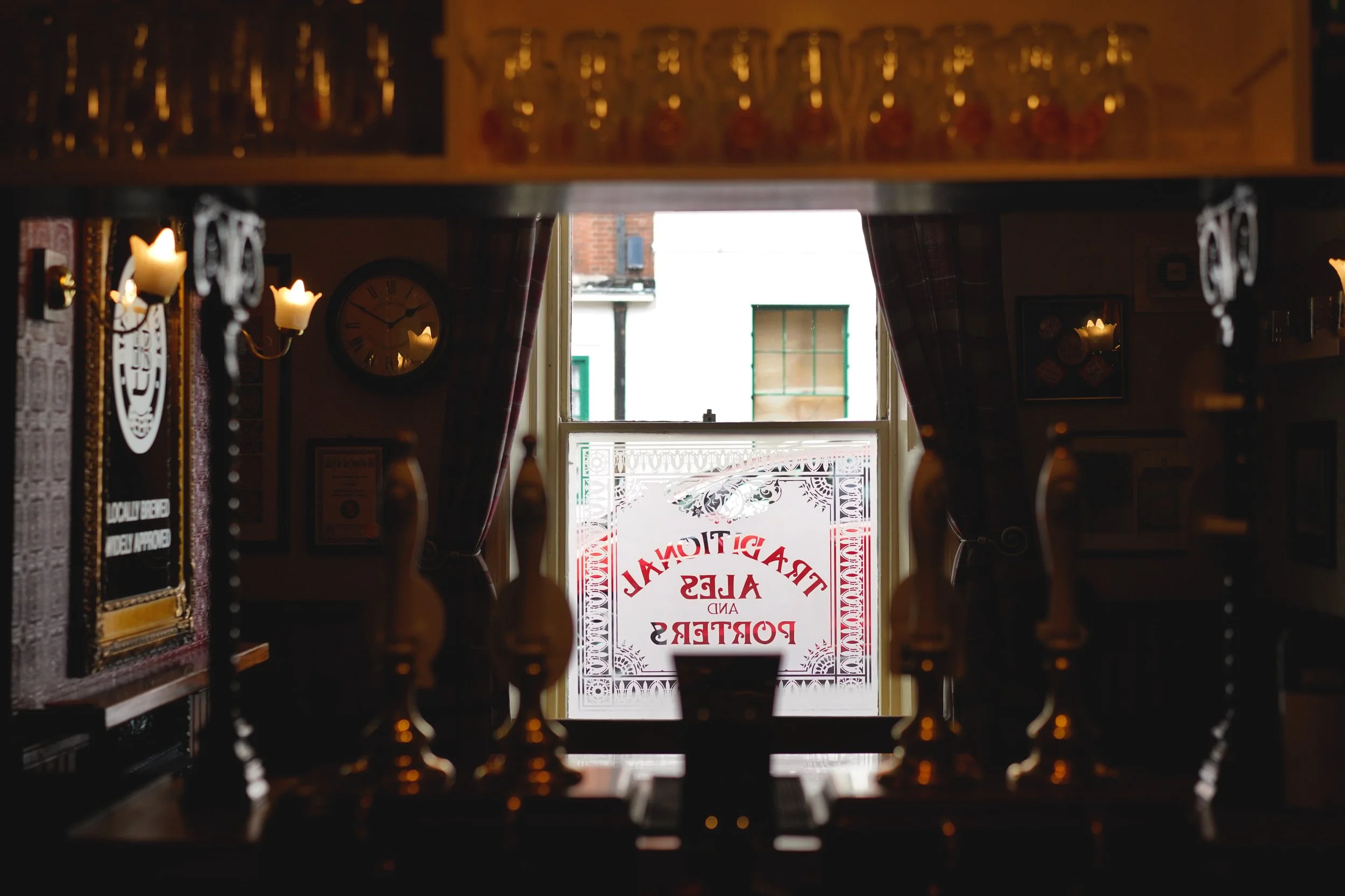A Public House — The Inseparable Stories of Joule’s Brewery and The Coopers Tavern
The pale grey clouds over Burton upon Trent reach down and disappear behind two ageing industrial buildings which flank railway tracks. I walk up the steps from the station into the town that was once the beer capital of the world and find myself surrounded by brewing on an industrial scale, both past and present.
Photography by Jack Spicer Adams
To my left the words ‘Midlands Railway Grain Warehouse No2’ are written in capitalised white font, three feet high and running across a solid black band the width of the three-storey Victorian warehouse, now converted into a modern hotel. Facing it across the tracks is the brick expanse of the former Allsopp’s Brewery, its arch-topped windows repeating and extending towards the horizon until capped abruptly by the tall metal fermenters of the Molson Coors brewery.
There’s no missing the fact Burton is a brewing town, and while the smell of hot wort still blows through the streets, many of the tens of thousands of brewery-related jobs once needed have been lost to automation and modernisation.
But shadows of a lost light are still cast across the town, and a short walk from the station and into a residential side street is the former Bass Brewery tap—The Coopers Tavern—named, of course, after the specialist crafter of wooden beer barrels, a profession once essential, but now redundant to the big brewers of Burton.
The Coopers Tavern is a true ‘public house’. Once a residential home with narrow doors and tight internal rooms, the large cream sign on the front reads ‘Bass & Cos Coopers Tavern’ in faded brown font, painted directly onto the Victorian brick and revealing its true purpose. Here since the early 1800s it was built to be a head brewer’s house, but a few decades later it was being used as overflow storage for speciality malt by the William Bass Brewery. By 1826 it was cellaring Bass’ famous Imperial Stout and by no small coincidence began being used by senior members of the brewery as their own personal pub.
Not officially licensed as a public house until 1858 the back room of The Coopers remained a private space for the brewers for almost a hundred years, right through until around the 1950s. Now the pub is anything but exclusive and locals and beer history-loving pilgrims share the space with ease—having visited the pub on dozens of occasions I hope I fall somewhere between the two, and always receive a warm welcome.
The serving bar occupies no more than a yard of space and expertly kept cask beers are drawn directly from the barrel or via four traditional black handpulls; to their right is a raised wooden L-shaped bench with a dark green seat and curved armrests worn smooth by decades of hands.
“That high bench in the corner was known as ‘The Gods’, where all of the head brewers used to congregate and have a beer together,” Mandy Addis, the licensee of The Coopers tells me.
“More people should come, they’d be amazed by it. I am still in awe, every day I walk in I just think yeah, this is it. This is what a pub should be. This is what it's about. This is what I wake up for every day, for people to come in and admire what we've got.”
I order a pint of cellar cool, foaming and perfectly conditioned pale ale from the handpull and quickly step out of the way as a queue of patrons quietly forms behind me—I’m occupying the single space at the bar.
““This is what a pub should be. This is what it’s about.””
It’s just past 5pm and the main room is circled by regulars facing inwards and making conversation; parts returning to form a familiar whole. Laughter erupts more often than arguments, and subsides just as quickly, with a change of conversation from politics to more important matters like football, or beer. The two small side rooms are quieter, with a handful of couples sitting at small, round, iron-legged tables, a stool either side, drinking and quietly exchanging words about their days.
“We’ve had people from Japan, from America, Australia, from literally all over the world visiting the pub—and I feel very privileged,” Mandy says. “It's the most unusual pub I've ever worked in, but the loveliest, it is a proper drinkers-talkers pub.”
Mandy’s genuine pride for the Coopers beams out of her descriptions and I can see how she has helped foster the convivial atmosphere the pub bursts with.
“Everyone that comes in walks out feeling like they've made a new friend—doesn't matter where they're from, because the regulars will always interact with whoever’s in.”
In amongst the ornate printed Bass ‘Burton Ale’ mirrors that decorate the walls are the wooden signs of a now lesser-known brewery, Joule’s, who for almost 200 years were bitter rivals of the still world-famous Bass. History is always written by the victors.
A sign for the ‘William Bass Meeting Room’ leads me into the small back room where a wooden plaque commemorates the history of the Joule’s Brewery, recounting how it was lost only to rise again.
In front of me sits my deep-gold pint of Joule’s timeless pale ale, glowing and topped with a bright white head of foam, which creates halos down the glass as I sip. But, really, this is a beer for glugging; a subtle well-balanced bitter, with a delicious caramel undertone from the pale tipple malt, a foil for the floral, drying, hop character. The overall impression is of a bittersweet, incredibly drinkable ale, a balm for dry workers’ throats which slips down pint after pint. Underpinning the beer is the same mineral-rich water which made the brewery’s pale ales so sought after a century or so ago, drawn from an ancient Triassic aquifer.
In an age before water-chemistry was a part of a brewers’ arsenal it was this town’s gypsum rich waters which helped beers from the region play in a league of their own, enhancing hop character and giving the trademark ‘Burton Snatch’—a lightly sulphurous aroma that can take a little time to get used to.
“You still get that sulphur when you open the cask, just that smell which is absolutely gorgeous.” Mandy tells me. “It’s just due diligence and care. From when the beer is delivered we store it properly, look after it, and once it's on we only ever serve it for three days.”
***
Joule’s history stretches back beyond even the origins of India Pale Ale, all the way back to 16th Century Augustinian Monks, who adorned each barrel of the beer they brewed with a red cross by way of blessing.
The Monk’s red cross was later adapted by John Joule to become the Joule’s distinctive thick red cross and in 1867 became the 6th oldest beer trademark in the world after Bass’ Red Triangle, Bass Diamond, Guinness Harp, Whitbread Unicorn and Berry Brothers Barrel. At its height Joule’s was the same size as Bass, producing huge volumes of ale serving a thriving 200 strong pub estate.
In the 1970s Joule’s suffered a swift and devastating hostile takeover by rival brewers Bass, who immediately closed the brewery and sacked the workforce. The Bass and Joule’s brands ended up being broken up and sold as parts to (the company now known as) Anheuser-Busch InBev and Molson Coors, with Joule’s falling to the latter. The beers, the brand, and that once world-famous trademark were seemingly lost forever—until being rediscovered by a brand manager working at Molson Coors, who became fascinated by its distinctive red cross.
“The cross trademark is quite special. It's a perfect cross, and excluded from international [trademark] law because it predated the Red Cross,” says Steve Nuttall, the owner of the now independent Joule’s Brewery, which was established in Market Drayton, Shropshire, in 2010. “It's quite a special intellectual property—and it was just sat in a bottom drawer,”
““The Coopers is a special pub, and it just seemed poetic to have the meetings there.””
Despite Steve’s enthusiasm, Molson Coors weren’t looking to resurrect the brand and his efforts fell on deaf ears. “If anything they were consolidating, not adding brands, and I disappeared off into the world and did other things,” he says.
But the image of that perfect red cross hidden away in a bottom drawer stuck with Steve and when he eventually came back to the idea of starting his own microbrewery, he wondered if his former employer could be persuaded to part ways with the Joule’s brand.
“I had a few pubs by then with my wife. And we thought ‘what if?’... would Bass allow us? The brewery that we planned to build was in the back of an old Joule’s pub [the Red Lion in Market Drayton], and we found on some old photographs the pub used to have the Red Cross in the middle — the land even had access to the original mineral water. It just seemed the perfect place to reinvigorate the Joule’s brand – and that’s really where the story started.”
***
It was Steve’s whimsical idea to do the deal for ‘a pie and a pint’, asking Molson Coors to give up a brand they weren’t using in return for a supply contract to Steve’s fledgling pub estate. “‘Let us do the ale and we buy your lager,’ we said. But they sadly turned us down,” he tells me.
Steve is not a man to be deterred. Over the next two years a string of meetings were held in The Coopers, always in the William Bass meeting room, trying desperately to strike a deal with his former colleagues. The breakthrough came on the 4th February 2009, a date etched into the wooden plaque in front of me within The Coopers Tavern.
“The Coopers is a special pub, and it just seemed poetic to have the meetings there and I knew my old colleagues wanted to see the brand used,” Steve says. “What we eventually agreed was a licence. Instead of selling us the brand they gave us a licence in perpetuity, but we’d have to pay loyalties—so it tied us into them.”
Over several years, Steve began to add pubs to the estate and build the business back up, resurrecting the beers from Joule’s illustrious past. With recipes and brew records now in hand, head brewer Adam Goodall went about recreating the beers, but found that—thanks to the higher efficiency of modern hops—the beers were “off-the-scale bitter”, not the sessionable beers the brand was known for. They turned to Anthony Heeley, the last man to brew the beers back in 1974, who helped dial in the recipes with extensive tasting and testing.
What they were aiming for was something with huge drinkability, a beer which is there as a conduit for conversation and something which enhances an atmosphere rather than demands full attention.
It’s a hallmark you can taste across all of Joule’s beers, which are balanced, flavoursome and moreish, but rarely over-hopped or bitter. A pint of their recent Mosaic seasonal is a revelation—showcasing the hop with an incredible clarity of flavour whilst remaining hugely sessionable and light. Blossom and blueberry combining with the freshness of citrus zest on top a super-clean, sparklingly light pale malt body.
With the beers dialled in and the pub-estate growing, Steve’s relationship with Molson Coors became increasingly strained, the licence agreement becoming a weight around the neck of the now flourishing Joule’s brewery.
“Some of the people I knew had moved on and Molson Coors had now become a bit more commercially aggressive—hey started to knock us about a bit. They were quite pressing about what we could or couldn't do,” he says.
“It became clear to us that we couldn't really grow the business any further, particularly over generations. If we didn't own our own name, then we would just always be beholden to Molson Coors.”
After a number of deals which fell through due to disagreements between the UK company and the Canadian HQ, negotiations reached a crescendo with Steve stepping away from the deal entirely and deciding the only thing to do was to abandon his beloved Joule’s and set up a new brand. In playing his final hand, Steve forced Molson Coors into action and a deal was finally struck on the 21st April 2017.
“Molson Coors didn’t want to sell the brand to us and it just went on for several years,” Steve says. “We finally did the deal in 2017, and in the end signed the contract back in The Coopers for half a million pounds—it was the largest cheque I’ve ever written for fresh air.”
As it turns out it cost far more than a pie and a pint, but after a decade-long journey the Joule’s brewery in its entirety was fully independent once more.
Today Joule’s beers are served in just twenty of their own pubs, including The Coopers. I ask Steve what the future holds for the brewery and whether it matters more to preserve what they have or restore Joule’s former glories. But he doesn’t rise to the bait.
“Every one of our pubs is individual. The story of the pub and its character and its identity comes first,” he tells me. “And whilst Joule’s is a part of that, we want them to retain their own character. I hope our tenure will be a long one, but all of these pubs will last longer than the brands and the breweries that own them.”
“I just hope we’re good custodians—not just for five years, but for generations. That’s how you end up with a pub that everybody says ‘that’s always been good.’”


















